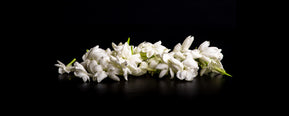Amber: The word alone conjures images of molten gold, glistening sunlit warmth, and something deeply sensual.
As one of perfumery’s most iconic ingredients, what amber smells like becomes a question rooted in fascination. From smoky and resinous to sweet and powdery, amber offers a complex experience that evokes emotion and timeless elegance.
Whether you're exploring a new signature scent or diving into the world of indie perfume, amber is a note that always leaves a mark. Let’s break down what amber really is, and why it continues to captivate noses around the world.
What is Amber?
Amber is a fantasy note in modern perfumery, an artistic blend of resins, balsams, vanillic tones, and musky accents designed to evoke a sense of warmth, richness, and exotic depth. It is not a single ingredient but a composed scent profile often built from labdanum, benzoin, and vanilla, mimicking the earthy sweetness of ancient amber resins.
That said, two common misconceptions still exist:
Many assume the amber in perfumes is the same as fossilized tree resin, a hard, golden substance used in jewelry and burned historically for scent.
Others mistake it for ambergris, a rare, waxy material secreted by sperm whales, once prized for its marine-animalic aroma. While both were historically used, neither is what modern perfumers use.
Instead, today’s amber is entirely crafted, by design. It captures the spirit of golden warmth and ancient mystery, while leaning on sophisticated synthetic molecules to offer consistent quality and ethical production.
What Does Amber Smell Like?
So, what does amber actually smell like? In short, it’s like the cozy scent of sun-warmed skin wrapped in vanilla, soft woods, and hints of glowing spice. It's comforting, golden, and familiar.
Core Scent Profile:
- Warm and rich: Like sunlight trapped in liquid form, this warmth often comes from labdanum and benzoin, two sticky, tree-derived resins with a natural honeyed depth.
- Sweet and slightly spicy: A velvety softness with a sensual kick, often thanks to vanilla, tonka bean, and traces of cinnamon or clove used in the blend.
- Resinous and balsamic: Hints of tree sap and aged woods, which are usually built from labdanum and benzoin, creating a dense, syrupy base.
- Musky or powdery: Depending on the blend, it can feel cozy and soft, thanks to modern synthetic musks or the addition of ambergris-like molecules such as Ambroxan.
- Incense or pine notes: Especially when heated or layered with frankincense or myrrh, which enhance the smoky, sacred side of amber.
Amber often reminds people of cozy spaces lit by candlelight, warm skin after a day in the sun, or the calm of a quiet autumn afternoon. It brings to mind the feel of soft fabrics like velvet or cashmere, and carries the same comforting depth you’d find in old libraries or sacred spaces where incense lingers in the air.
Depending on what it’s paired with, amber can take on a sweet and romantic character or lean more smoky and dark. This flexibility is why amber fits so naturally in both men’s and women’s fragrances. Its rich warmth makes it especially suited for fall and winter, when heavier, more comforting scents are most welcome.
Why Is Amber So Expensive?
Amber’s price reflects the craftsmanship behind its creation. Since true ambergris is no longer commonly used and fossilized resin isn’t viable in perfumery, perfumers must skillfully recreate amber’s allure through complex accords. These blends involve high-quality ingredients like labdanum, tonka bean, and synthetic molecules like Ambroxan.
In addition, amber often serves as the foundation of a perfume, supporting the full architecture of the scent. The depth, longevity, and blending role make it invaluable to perfumers, and its price follows suit.
Amber in Perfumery
Amber is almost always found as a base note, the scent that lingers long after the top notes fade. It plays a foundational role in the structure of a fragrance, offering depth, warmth, and staying power.
Functionally, amber acts as a bridge. It connects and blends other components, allowing transitions between citrusy top notes and floral or woody hearts to feel seamless. Its soft yet rich character makes it a favorite for layering.
You’ll find it especially in:
- Amber fragrances: rich, sensual, exotic
- Woody scents: structured, grounding
- Gourmand blends: adding syrupy warmth
- Chypres: balancing mossy sharpness with sweetness
Whether used in niche blends or mainstream eau de parfume, amber’s adaptability and emotional pull make it a go-to for perfumers. Why do they love it? Because amber doesn’t overpower, it supports. It lends longevity, enhances transitions between layers, and adds richness without dominance. Like a musical baseline, amber holds the fragrance together.
Variations of Amber in Perfumery
Amber’s versatility is one reason it appears in so many fine collection perfumes.
Amber isn’t one-size-fits-all. There are several distinct variations, each found in different types of perfumes or regions, depending on the scent’s purpose and cultural background:
- Amber Accord: The most common, blending resins like labdanum, benzoin, and vanilla. Found widely in Western perfumery across both niche and designer brands.
- Ambergris (Natural): Oceanic, animalic, and extremely rare. Historically used in high-end French perfumes, but now mostly seen in heritage or vintage-inspired compositions.
- Ambroxan: A modern molecule mimicking ambergris with clean, musky warmth. Popular in minimalist or fresh fragrances and often found in men’s colognes.
- Amberwood: A woodier, drier take used in contemporary men’s scents. Frequently seen in modern designer perfumes that emphasize strength and longevity.
- Amber Fougères: Green and herbal with warm undertones. Typically found in classic barbershop-style or vintage colognes.
These versions allow perfumers to tailor amber’s tone to match the story they want to tell, be it sultry, clean, smoky, or floral.
What Scents Pair Well With Amber?
Amber’s warm, smooth character makes it an ideal anchor for many other scent families. It enhances florals like rose and jasmine, creating blends that feel romantic and soft.
Paired with fruity notes like pear or berries, amber takes on a playful, almost gourmand sweetness.
Citrus elements like bergamot and orange brighten amber’s richness and make it feel lighter and fresher.
Woods such as cedar and sandalwood bring out amber’s earthy side, adding structure and grounding to the scent.
Spices like clove and cinnamon amplify its warmth, giving the blend a cozy, spiced quality. And when combined with resins or incense, amber reveals its deepest, smokiest facet, perfect for more intense or meditative fragrances.
Benefits of Amber in Aromatherapy
Amber’s scent is more than pleasant. It’s calming, warm, and emotionally soothing. In aromatherapy, it’s often used to help people feel more grounded and relaxed. The soft, earthy fragrance can reduce stress, promote better sleep, and create a cozy, peaceful atmosphere.
Its sweet, musky tone can also spark feelings of connection and warmth, making it a favorite in massage oils and home scents. Whether used in perfume, candles, diffusers, or oil blends, amber adds a gentle sense of comfort to any space.
Amber at Buchart Colbert
At Buchart Colbert, amber adds depth, warmth, and character to a range of unique scents. It's rarely the star, but it always supports the story, enhancing each blend with texture, emotion, and long-lasting presence.
From smoky to soft and spicy, what amber smells like becomes clear when you explore how it’s used in each Buchart Colbert creation.
- L’Hantise uses amber as a smoky anchor beneath nostalgic florals and citrus. It grounds the dreamlike quality of the scent with a mysterious, ozonic finish.
- Mischa features amber in the base to soften the boldness of saffron and neroli. It adds quiet elegance and balance, helping the floral-citrus mix feel polished and serene.
- Faisan d'Or leans on amber for boldness and spice. Woven into caramelized sugar, warm woods, and orange, amber amplifies the richness and autumnal feel of the blend.
- Lutin Errant uses amber to stabilize a playful mix of rum, musk, and mushroom. It gives structure and warmth to the scent’s more adventurous, unexpected notes.
Our Sample Discovery Set is a perfect way to explore our debut range and also includes a $49 credit towards a 50 mL bottle.
FAQ
1. Is amber sweet or musky?
Amber is both. Most amber blends combine soft, vanillic sweetness with a musky or powdery base that adds sensuality and depth. The result is smooth, warming, and often nostalgic.
2. What’s the Difference Between Amber, Black Amber, and Dark Amber in Perfumery?
- Amber: A warm, sweet, and resinous accord made from ingredients like labdanum, vanilla, and benzoin.
- Black Amber: A darker, richer version of amber, often blended with patchouli, incense, or sweet myrrh. It’s more earthy and smoky, used to create mysterious, sensual depth.
- Dark Amber: The most intense variation, with animalic, leathery, or oud-like notes. It has a smoldering, dramatic character, ideal for bold, moody compositions.
3. Is amber unisex in fragrance?
Absolutely. Amber’s multifaceted profile allows it to blend seamlessly into both masculine and feminine fragrances, or stand alone in genderless formulations. It’s as adaptable as it is iconic.


